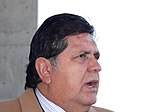Alianza Popular Revolucionaria Americana
| Alianza Popular Revolucionaria Americana American People's Revolutionary Alliance |
|
|---|---|

|
|

|
|
| Party leader | Office vacant, previously Alan García († April 2019) |
| Secretary General | Omar Quesada Martínez |
| founding | May 7, 1924 |
| Headquarters | Lima |
| Alignment |
Social Democracy Democratic Socialism Progressivism |
| Colours) | red |
| Parliament seats | none (January 2020) |
| Website | www.apra.org.pe |
The Alianza Popular Revolucionaria Americana (APRA) ("American People's Revolutionary Alliance") is the oldest existing Peruvian political party. It was founded on May 7, 1924 by Víctor Raúl Haya de la Torre . APRA provided a Peruvian President, Alan García , who ruled from 1985 to 1990 and from 2006 to 2011.
history
Founding years
The APRA was founded by Haya de la Torre on May 24, 1924 in Mexico City as a Latin American collection movement. In an article in the English-language magazine The Labor Monthly from December 1926, he published the principles of the APRA as a Latin American (or "Indian-American") united front:
- Fight against "Yankee Imperialism "
- For the political unity of Latin America
- For converting land and industry into public property
- For the internationalization of the Panama Canal
- For solidarity with all oppressed peoples and classes in the world
In 1927 the first political organization of the APRA was founded in Paris . On September 20, 1930, the Partido Aprista Peruano was finally founded as the national Peruvian organization of the movement. The party initially found supporters among the workers on the sugar cane plantations and in the sugar refineries in northwestern Peru.
The APRA organized its supporters outside of the political arena in associations for workers, students and freelancers. She built “Volkshäuser” in many cities, where evening courses and various services, e.g. B. cheap restaurants were offered. The party's supporters waved a white handkerchief while greeting.
Up and down under Haya de la Torre
In the Peruvian presidential election in 1931, Haya de la Torre ran for the first time as a candidate for the APRA. In the same year the party was banned and Haya de la Torre was imprisoned for 15 months.
In 1945, José Luis Bustamante y Rivero , who also had the support of the APRA, was elected president and the APRA was legalized again. After uprisings in 1948, a renewed ban followed until 1956.
The ideological orientation of APRA was subject to fluctuations. In the 1950s, Haya de la Torre made opportunistic approaches to the right-wing camp; the Peruvian Communist Party was founded as a split from the APRA under José Carlos Mariátegui . In the 1962 presidential election, Haya de la Torre was in the lead after one ballot, but the election was canceled and a military junta took power. In the next election in 1963 he was defeated.
The García era
After many ups and downs, APRA came to power for the first time in the 1985 elections under the leadership of the new, populist-oriented President Alan García . His presidency was marked by hyperinflation , unrest and guerrilla fighting, human rights violations and economic decline, which eventually led to García's resignation in 1990 and a severe election defeat for APRA. In the first elections after the resignation of President Alberto Fujimori , García, who had meanwhile returned from exile, only narrowly failed with 48% of the votes in the second ballot against Alejandro Toledo . In the presidential elections in 2006 Alan García ran again for the office, which he won on June 4, 2006 in the runoff against the best-placed in the first ballot, the left-wing nationalist Ollanta Humala , with 55 percent of the vote. In the Congress, which was also newly elected in 2006, the APRA was the second largest parliamentary group with 36 of 120 members. In the 2011 congressional elections , APRA suffered a severe slump and could only bring 4 MPs into Congress. In the early parliamentary elections in January 2020 , she failed to make it into parliament with 2.72% of the vote.
The APRA belongs to the Socialist International , even if the APRA is only slightly socialist in its orientation.
Web links
- Official website of APRA (Spanish)
- Official party organ of APRA (Spanish)
- Latin American studies (including a dispute between Torre and Mariategui)
Individual evidence
- ↑ ONPE: Resultados al 100% de las Elecciones congresales 2020 , La República, February 18, 2020
- ^ Julio Cotler: Political Crisis and Military Populism in Peru . In: Heinz Rudolf Sonntag (ed.): The case of Peru. “Nasserism” in Latin America to Overcome Underdevelopment? A critical inventory . Peter Hammer Verlag, Wuppertal 1971, ISBN 3-87294-026-0 , pp. 25–112, here p. 37.
- ↑ ONPE: Resultados al 100% de las Elecciones congresales 2020 , La República, February 18, 2020
